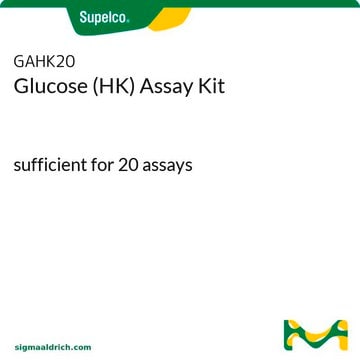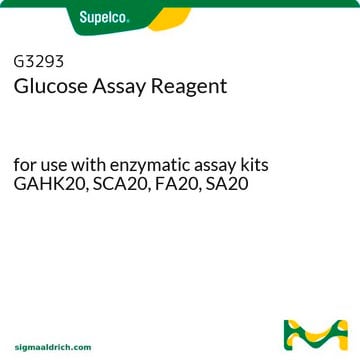T8778
Trehalase from porcine kidney
buffered aqueous glycerol solution, ≥1.0 units/mg protein
Synonym(s):
α,α-Trehalose glucohydrolase
Sign Into View Organizational & Contract Pricing
All Photos(1)
About This Item
CAS Number:
MDL number:
UNSPSC Code:
12352204
NACRES:
NA.54
Recommended Products
form
buffered aqueous glycerol solution
specific activity
≥1.0 units/mg protein
concentration
0.5-10.0 mg/mL protein (BCA)
storage temp.
−20°C
General description
Trehalase is a glycosidase that occurs in many forms and is found in all tissues. It belongs to the glycoside hydrolase 37 (GH37) family of the carbohydrate-active enzyme (CAZy) classification.
Trehalose is the main haemolymph sugar in most insects and is potentially a prime target for an invading pathogenic fungus.
Application
Trehalase has been used:
- in a study to assess changes in carbohydrate metabolism in Plasmopara viticola-infected grapevine leaves
- in a study to investigate growth arrest by trehalose-6-phosphate
- to quantify the intracellular trehalose in Lactobacillus casei cells
Biochem/physiol Actions
Trehalase catalyzes the hydrolysis of trehalose to produce two glucose units. It mediates flight metabolism, molting induced chitin production and tolerance towards cold temperature.
Unit Definition
One unit will convert 1.0 μmole of trehalose to 2.0 μmoles of glucose per min at pH 5.7 at 37 °C (liberated glucose determined at pH 7.5).
Physical form
Solution in 50% glycerol containing 1% Triton™ X-100 and 25 mM potassium phosphate, pH 6.5
Legal Information
Triton is a trademark of The Dow Chemical Company or an affiliated company of Dow
Storage Class Code
10 - Combustible liquids
WGK
WGK 2
Flash Point(F)
Not applicable
Flash Point(C)
Not applicable
Certificates of Analysis (COA)
Search for Certificates of Analysis (COA) by entering the products Lot/Batch Number. Lot and Batch Numbers can be found on a product’s label following the words ‘Lot’ or ‘Batch’.
Already Own This Product?
Find documentation for the products that you have recently purchased in the Document Library.
Customers Also Viewed
Shari Dhaene et al.
Journal of enzyme inhibition and medicinal chemistry, 35(1), 1964-1989 (2020-11-10)
Although trehalose has recently gained interest because of its pharmaceutical potential, its clinical use is hampered due to its low bioavailability. Hence, hydrolysis-resistant trehalose analogues retaining biological activity could be of interest. In this study, 34 4- and 6-O-substituted trehalose
Growth arrest by trehalose-6-phosphate: an astonishing case of primary metabolite control over growth by way of the SnRK1 signaling pathway
Delatte, T., et al.
Annual review of plant physiology and plant molecular biology, 157, 160-174 (2011)
Davide Bini et al.
Beilstein journal of organic chemistry, 8, 514-521 (2012-04-18)
A small set of nojirimycin- and pyrrolidine-based iminosugar derivatives has been synthesized and evaluated as potential inhibitors of porcine and insect trehalases. Compounds 12, 13 and 20 proved to be active against both insect and porcine trehalases with selectivity towards
Christopher Askew et al.
PLoS pathogens, 5(10), e1000612-e1000612 (2009-10-10)
Glycolysis is a metabolic pathway that is central to the assimilation of carbon for either respiration or fermentation and therefore is critical for the growth of all organisms. Consequently, glycolytic transcriptional regulation is important for the metabolic flexibility of pathogens
Jiangnan Luo et al.
PloS one, 9(6), e99732-e99732 (2014-06-14)
A set of 14 insulin-producing cells (IPCs) in the Drosophila brain produces three insulin-like peptides (DILP2, 3 and 5). Activity in IPCs and release of DILPs is nutrient dependent and controlled by multiple factors such as fat body-derived proteins, neurotransmitters
Our team of scientists has experience in all areas of research including Life Science, Material Science, Chemical Synthesis, Chromatography, Analytical and many others.
Contact Technical Service










